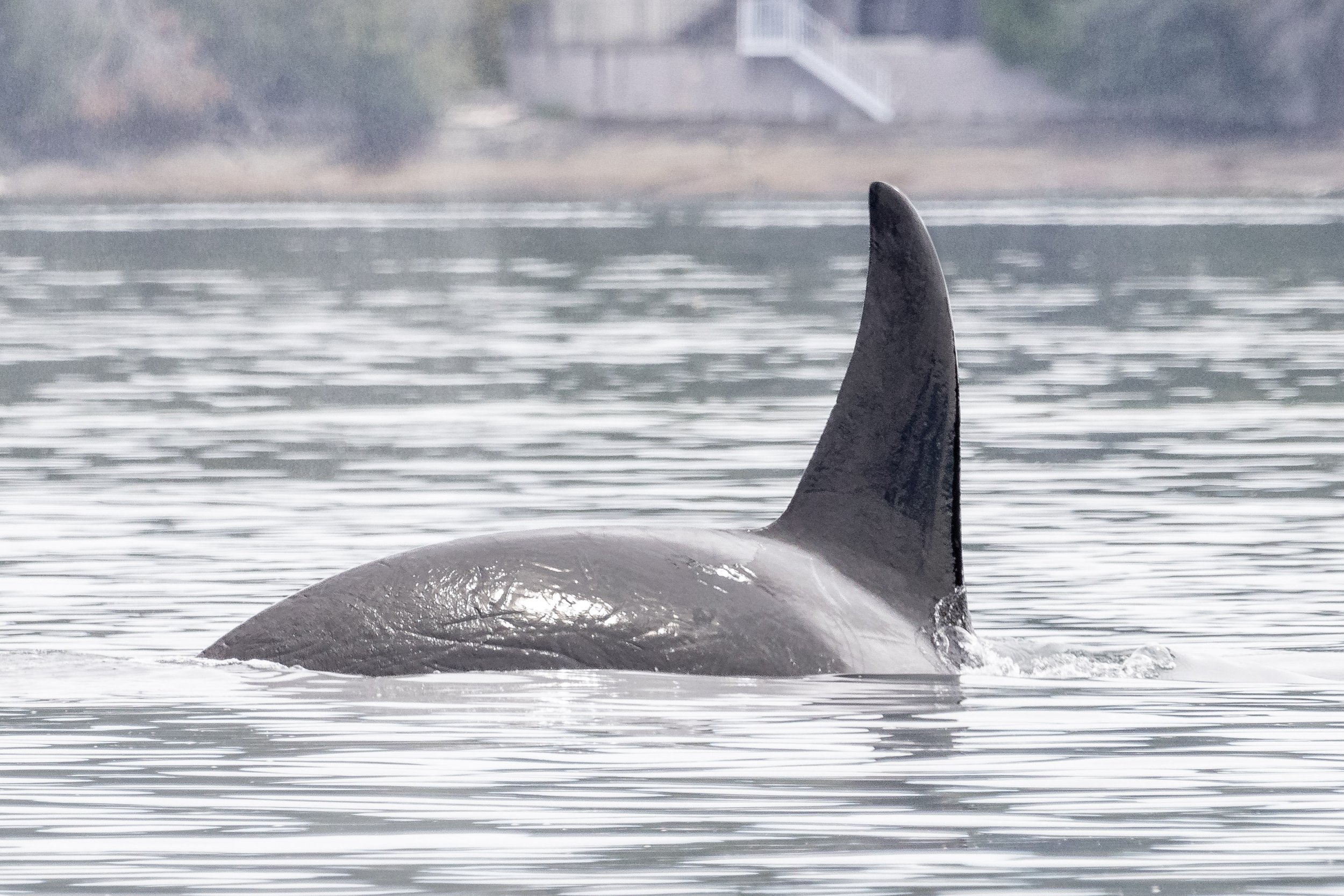June 28, 2024, 10:30 AM - Orca party time!
Life is great when we see wildlife before we leave the harbour! Guests were treated to some rascally River Otters on the docks as they suited up. These guys are frequent visitors, and we never tire of their antics. Once loaded up, we headed south through the Gulf Islands, sailing through Dodd Narrows and travelling towards Stuart Channel. Just west of Thetis Island, we ran into our first pod of the day, the T099s! This family consists of the following animals:
T099 Bella ♀ (~1984)
T099B Holly ♀ (2007)
T099C Barakat ♂ (2009)
T099D Puck ♂ (2015)
T099E ♀ (2021)
These guys were pretty active today! Guests were treated to tail slaps, pec slaps and some general milling around. It looked like the family was on a bit of a hunt when we arrived! Sometimes it’s fairly obvious when a hunt is successful, other times it can be a bit more unclear. Hunting is a team sport for the Orca, and we always see lots of action and cooperation during this time. This family is easy to ID thanks to Holly’s distinct dorsal. Check out the pics below to see for yourself! We’ve enjoyed watching this family for the past couple of years, and it’s been super exciting to see Barakat get bigger and bigger. He is just starting to hit puberty, and we can’t wait to see how big we will be! We soon found another group nearby, this time it was the T065As and a lone female, T037A1 Inyo. The members of this group include:
T065A Artemis ♀ (1986)
T065A2 Ooxjaa ♂ (2004)
T065A3 Amir ♂ (2007)
T065A4 Ellifrit ♀ (2011)
T065A6 Callisto ♀ (2018)
T037A1 Inyo ♀ (2007)
This lovely little family is always a pleasure to watch, with a good mixture of males and females of different ages. Orcas are sexually dimorphic, which means that they differ between males and females in terms of appearance. When these guys hit puberty, around age 10-15, male dorsals will begin to “sprout”. These dorsal fins will continue to grow as the young whale does, and can eventually reach heights of up to 6 feet when full-grown! Because males and females look the same when they are juveniles, it can be difficult to identify gender when they are young. Young whales get an ID number at birth, but it often takes a few years for them to receive their nicknames. This can lead to some “surprises” as whales go through puberty, and such is the case with this family. T065A3, originally “Amira”, now goes by “Amir” as he continued to grow larger than expected.
We stayed with the family as they comfortably travelled down the channel, splitting up a bit and zigzagging. Once our hour was up, we continued on to see other wildlife nearby. We popped over to Stinky Rocks, and saw a ton of different wildlife as the sun finally emerged! Our tours are not only great for whale lovers, but bird enthusiasts as well! We were treated to a flock of Pigeon Guillemot, a Bald Eagle, Turkey Vultures, and Black Oystercatchers, all hanging out at our favourite rocky spot. But the real stars of Stinky Rocks are the Steller Sea Lions, a real crowd favourite. As their numbers begin to dwindle as the summer goes on, we truly cherish every week we get with them. Soon they’ll all be off to their rookeries up island, but for now, it’s such a treat to spend time with them. We finished the day checking out another member of the Pinniped family, the Harbour Seals and paid a quick visit to the cormorants at the bluffs. Another great day in the Salish Sea!
All photos were taken by onboard Naturalists Val Watson and Lucy Willis.
Bath time for the River Otters! Photo by Val Watson.
T099 Bella. Photo by Val Watson.
T099 Bella with her youngest calf T099E behind her. Photo by Val Watson.
T099C Barakat lifting his flukes. Photo by Val Watson.
T099B Holly. Photo by Val Watson.
T099C Barakat. Photo by Val Watson.
T099C Barakat beside his sister T099B Holly. Photo by Val Watson.
T099C Barakat. Photo by Val Watson.
T099B Holly. Photo by Val Watson.
T099 Bella. Photo by Val Watson.
T099 Bella and T099E. Photo by Val Watson.
T099D Puck. Photo by Val Watson.
T099 Bella and T099E. Photo by Val Watson.
T099B Holly. Photo by Val Watson.
T099D Puck. Photo by Val Watson.
T099C Barakat with some sea grass on his dorsal. Photo by Lucy Willis.
T099C Barakat. Photo by Lucy Willis.
T037A1 Inyo and T065A4 Ellifrit. Photo by Val Watson.
T065A4 Ellifrit. Photo by Val Watson.
T065A Artemis. Photo by Val Watson.
T037A Inyo. Photo by Val Watson.
T037A1 Inyo and T065A4 Ellifrit. Photo by Val Watson.
T065A2 Ooxjaa. Photo by Lucy Willis.
A half eaten Fried Egg jellyfish. Photo by Val Watson.
A flock of Pigeon Guillemot. Photo by Val Watson.
A Black Oystercatcher. Photo by Val Watson.
A soaring Turkey Vulture. Photo by Lucy Willis.
A pair of cormorants. Photo by Lucy Willis.
A beautiful Bald Eagle. Photo by Val Watson.
Look at how fluffed up this Bald Eagle is! Photo by Val Watson.
Stretching and sun bathing sea lions! Photo by Val Watson.
A very large male Steller sea lion. Photo by Val Watson.
Some sleepy Harbour seals. Photo by Val Watson.
Our Open Zodiac Keta. Photo by Val Watson.


































